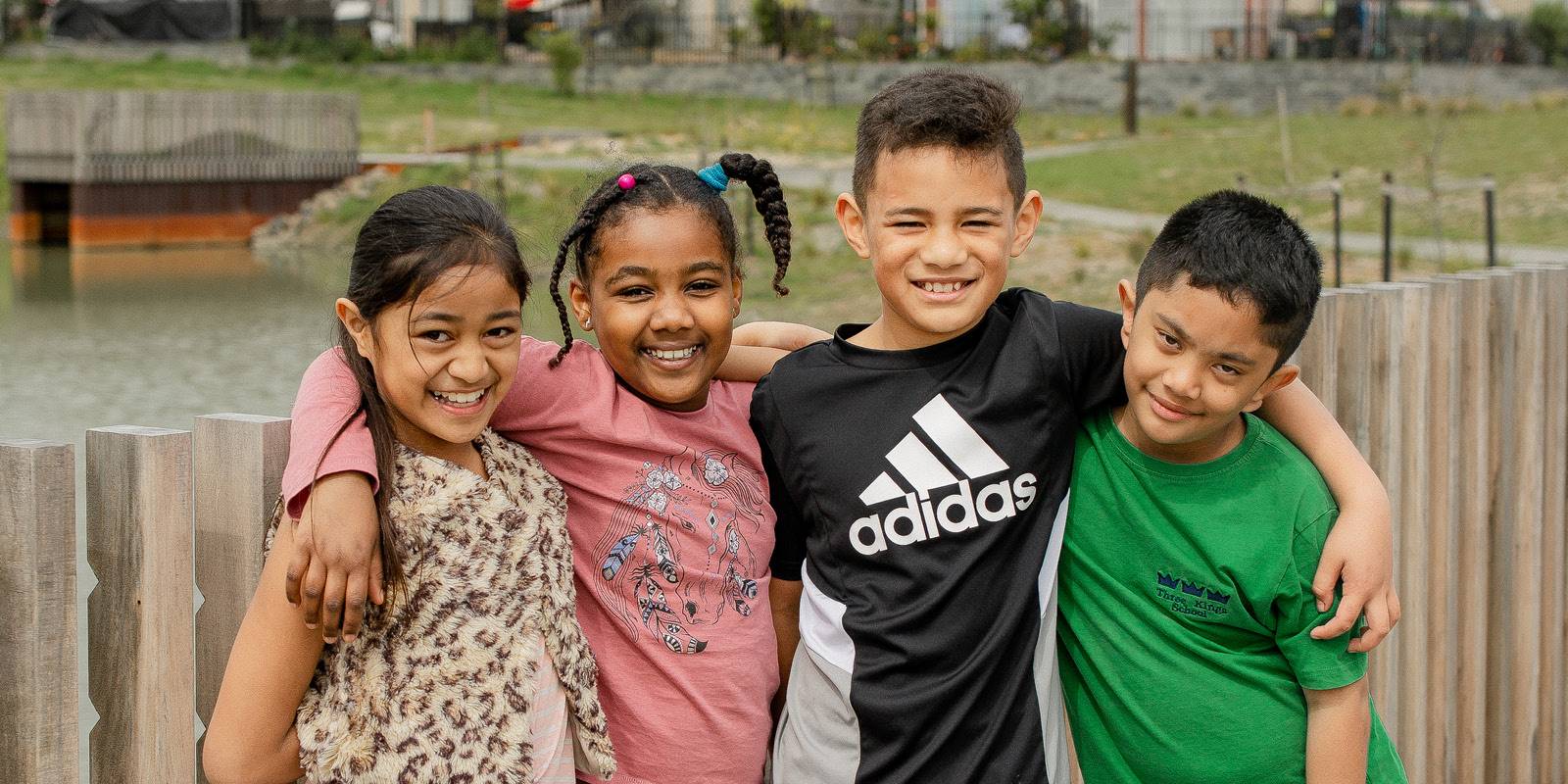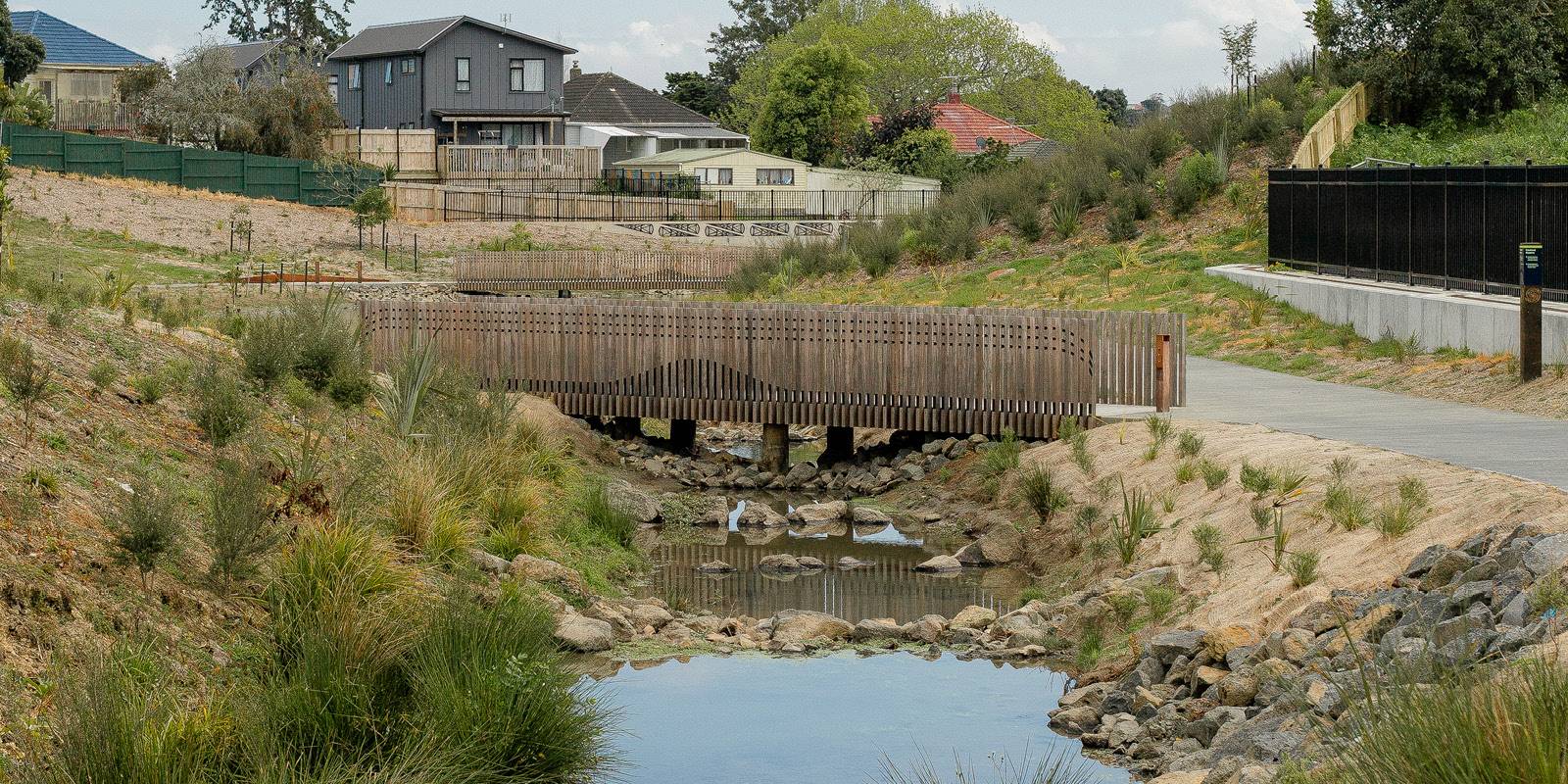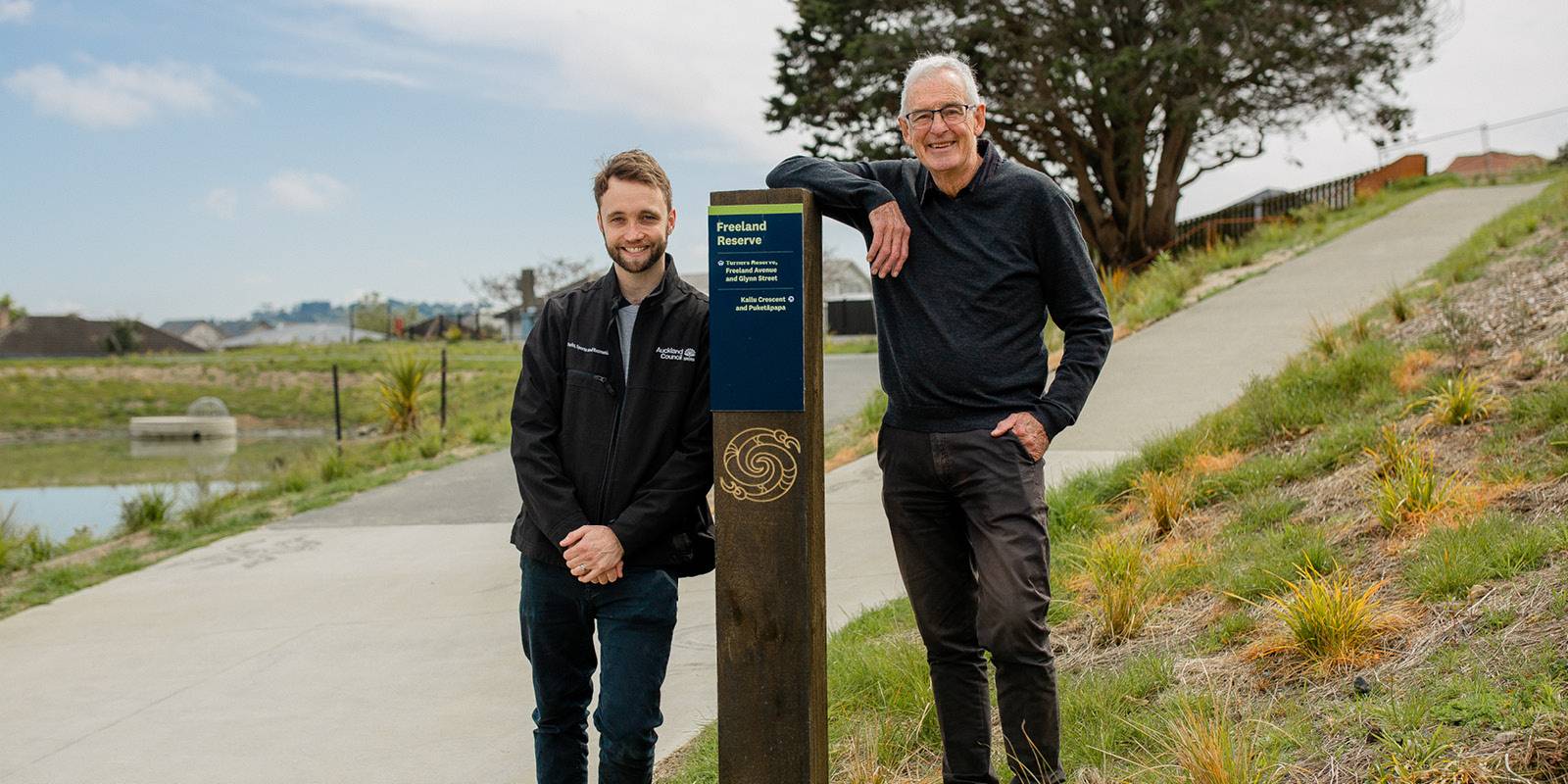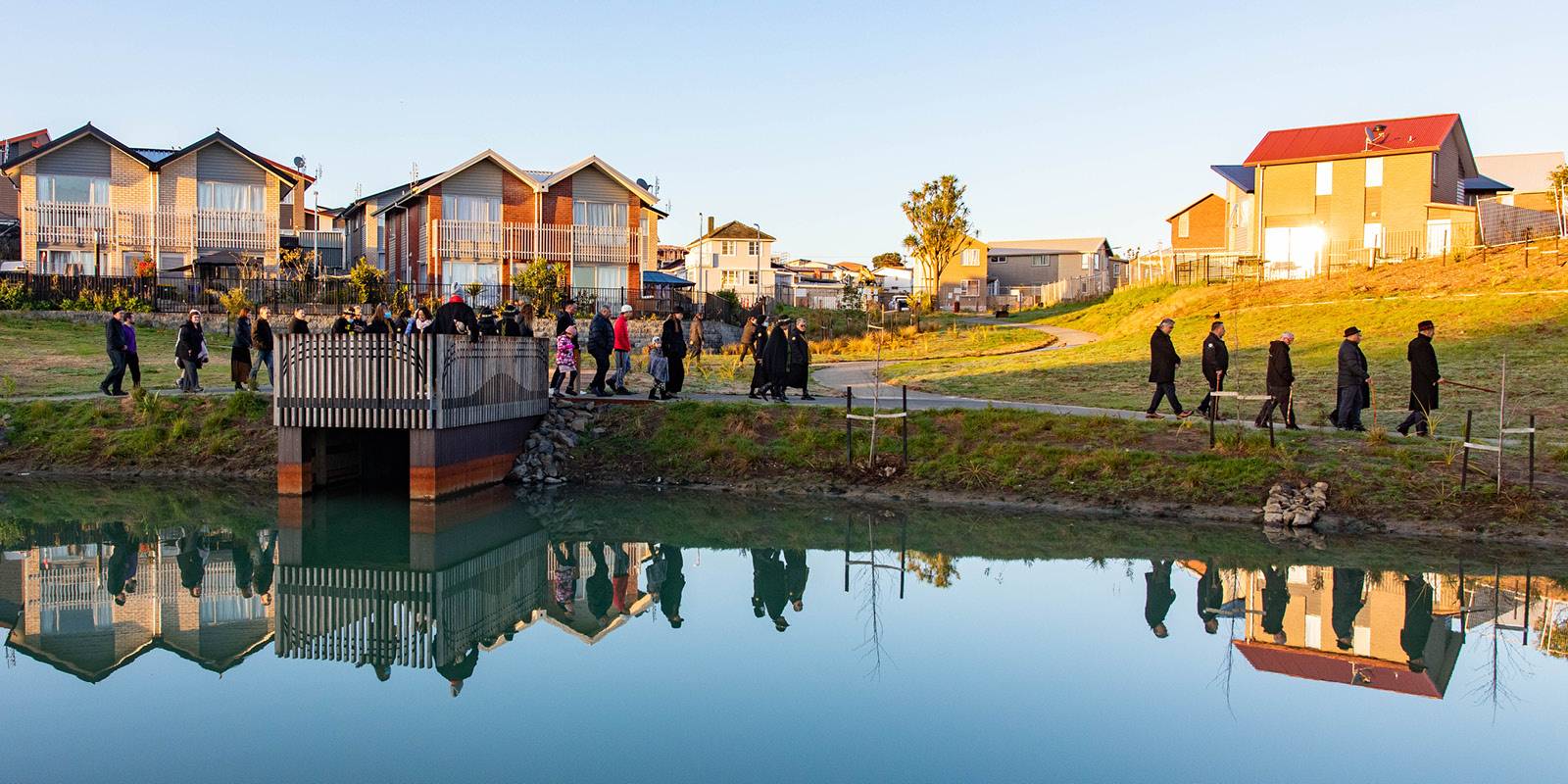A symbol for unity
Te Auaunga, which means ‘swirling waters’ (otherwise known as Oakley Creek), is the longest urban river, or awa, in the Auckland isthmus, flowing about 15 kilometres from the ridgeline above Waikōwhai to the Waitematā Harbour.
It runs through three local wards (Puketāpapa, Albert- Eden and Whau) and many different communities and cultures.
Years of work on restoring Te Auaunga has united these groups, and has given the community a beautiful extended parkway for walking, cycling, playing, or just hanging out with friends and neighbours. This unification has been formalised through a single symbol, Te Tohu o Te Auaunga, which can be spotted along the length of the stream. The Tohu’s latest appearance is at the newly opened Freeland Reserve.
A fresh environment
Kāinga Ora has been working closely over the last two years with Healthy Waters (Auckland Council) to upgrade Freeland Reserve, near the origin of the main tributary of Te Auaunga.
Their work means that flooding risk will be further decreased and water quality improved, which contributes to the mauri, or life force, of the awa. In addition, the area has been transformed into a new park, complete with native plants, a walkway, footbridges and even a viewing platform over the water. You’ll find the Tohu here and if you venture further along Te Auaunga, you’ll begin to see it everywhere.
Designing the Tohu
Tohu, in te reo Māori, means ‘mark, symbol, emblem or landmark’. The Te Auaunga Tohu came about as part of the process of the Puketāpapa Local Board, mana whenua and Friends of Oakley Creek working collaboratively on producing an Upper Catchment Strategy back in 2015-16. It was felt that having a symbol that was unique to the awa was very important.
The Tohu is a beautiful piece of artwork developed to represent the awa and its relationship to the environment and the people of the land through which it flows. It was designed by Tohunga Wikuki Kingi (Tainui, Ngai Tai) and Sunnah Thompson (Te Kawerau a Maki; Te Wai o Hua) of Whaotapu (Sacred Chisels). Whaotapu is a collective of Mana Whenua Tohunga, Master Carvers, and Kainga Toi. They express Te Ao Māori and the stories of whenua (land), wai (waters), and tangata whenua (people of the land) through their creations.
A slice of history
Two hundred years ago this whenua looked very different. In the mid-upper part of the catchment the river was part of a vast wetland called Te Wai o Rakataura (the waters of Rakataura), which was full of native birds and fish, building and weaving materials such as raupō and harakeke, (bulrushes and flax), and rongoā (medicinal plants) – all of which were sustainably harvested by Māori with future generations in mind. The wetland had another important natural feature, too: it absorbed and filtered seasonal floodwaters.
During the 1840s the land was taken over by early settlers, who drained wetlands and cleared the forests to build homes and farms. Housing intensification was booming by the 1950s – but flooding was becoming problematic because houses had been built on the natural floodplains. Encasing the awa in concrete pipes and channels was thought to be the best way to prevent this. As we now know, it wasn’t.
Mana Whenua come to the Council
The Te Auaunga restoration in terms of a flood mitigation project was first discussed at Council nearly ten years ago and formally documented in 2016. Harry Doig of the Puketāpapa Local Board has an engineering background, and for most of his years at council, he had referred to the awa as simply a ‘stormwater reserve’, a label he now speaks of rather ruefully. Harry remembers his first hui with representatives of the various local iwi. “In that first meeting, I listened to people whose ancestors had lived in this area for hundreds of years explain patiently to us what it meant to them. How it was not simply a drain, but was a living taonga which had once nurtured communities in every way, and could do again.”
Harry pauses to reflect. “I’d say that hui was actually a life-changer for me. I look at the stream in a completely different way these days.” Others agree that the process of restoring the awa has been extraordinary in unifying and educating the diverse groups involved about the importance of the awa, including all three of the local boards.
Bringing back the mauri of Te Auaunga
For Māori, a healthy waterway is critical to the health and wellbeing of the people who live around and depend on it. It has its own mauri, or life force, which helps it to sustain healthy ecosystems, including flora and fauna; and to support mara kai (food gardens).
The mauri of Te Auaunga stream had been much reduced, but now it’s blooming again, with rubbish gone and thousands of native species planted. Friends of Oakley Creek, led by Wendy John, has been working particularly hard on this for almost 20 years – and many other groups and individuals have joined them with the common goal of restoring the awa.
“It’s great to see another part of our awa restored at Freeland Reserve, and to have the beautiful Tohu as a unifying symbol linking it to the rest of the catchment,” says Wendy.
“Some parts of Te Auaunga look completely different to others and the Tohu helps you realise it’s all the same body of water running beside you, which is very special.”
You’ll find the Tohu at Freeland Reserve and you’ll see it too on other signage, pou, murals and more along the length of Te Auaunga. Perhaps when you see it you’ll think of the history of the awa, how it flows behind you into the past – and ahead of you into the future.
Symbolism of te Tohu o Te Auaunga
The design of the Tohu encompasses specifically selected elements. Unaunahi or fish scales represent fish and tuna (eels), while pungawerewere (a stylised spider) represents the insects living in and around the awa. Manaia, symbolised by two birds, show seasonal change, and niho taniwha, the taniwha tooth, symbolises the peak of our aspiration to restore Te Auaunga to what it was. The colours of the Tohu - kahurangi (blue) and kakariki (green) embody the skies, water and plantings of te awa. Finally, the spiral represents encircling arms of mana whenua and the ripples of the living waters.

